Mexico City, Mexico—Xolchimilcho is a neighborhood to the south of sprawling Mexico City.
 I traveled here recently in search of the Niño Pa, a 450-year old wooden statue depicting the infant Jesus that’s much beloved in these parts, and is the cause of gastrophilanthropy on a nearly fantastic scale.
I traveled here recently in search of the Niño Pa, a 450-year old wooden statue depicting the infant Jesus that’s much beloved in these parts, and is the cause of gastrophilanthropy on a nearly fantastic scale.
When I asked some of my Mexican friends for help in planning this trip, they were frustratingly vague with directions. Don’t worry, they promised, the statue is easy to find. It is watched over by one family for a year at a time, and their house becomes a well-known pilgrimage site. Upon arriving in Xochimilco, I could ask anyone where the baby lived, and I’d be given directions immediately.
I’ll admit, I was dubious about this. Mexico City has over 20 million people, and Xochimilco is one its most populous neighborhoods, comprised of 17 different barrios. It seemed unlikely that everyone I encountered there would know the exact whereabouts of a centuries-old chunk of painted wood.
The Niño Pa also has a busy daily schedule, and several times a week is carried forth to visit other homes, hospitals, schools and churches.
However, no sooner had I stepped out of the taxi I’d taken from Mexico City’s historic center (Centro Historico), then an old lady who was selling churros, or Mexican breakfast pastries, waved to me. Asking the taxi to wait, I walked over and bought a churro. Then, feeling quite ridiculous, I haltingly inquired, “Por favor, Señora. A donde vive el Niño Pa?”
Well. It was as if I’d mentioned the woman’s favorite movie star, soccer player, or better still, a child of her own. A smile spread the corners of her mouth wide, and her eyes lifted towards the heavens as if she were overcome with happiness. Rubbing her hands together in a “this-may-take-awhile” gesture, she told me that her mother was guardian to the statue back in the 1960’s, and that she herself housed the Niño Pa thirty years ago. She explained that although the statue lives with one family, theirs’ is primarily a night-time job. The Niño Pa also has a busy daily schedule, and several times a week is carried forth to visit other homes, hospitals, schools and churches. Just as his primary guardian is expected to feed and give shelter to anyone who comes to see the Niño Pa, a family who assumes a day’s custody will also offer a meal to everyone who encounters the baby while he is under their watch.
She was speaking quickly, and my Spanish to English translation can sometimes create more poetry than was perhaps intended. Still, I was pretty sure she concluded her remarkably enthusiastic speech with the phrase, “Everywhere el niño goes, he floats on a cloud of love.”
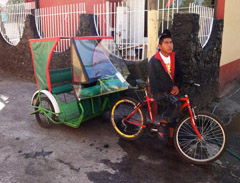 The woman then gave a shout and a vigorous hand signal to a teenaged boy who was lingering across the street. He quickly pedaled over on a bicycle rickshaw. Hesitant about this, I suggested I’d prefer to take my taxi which was still waiting for me at the curb. The woman laughed, explaining that where I was going was impossible to get to by car.
The woman then gave a shout and a vigorous hand signal to a teenaged boy who was lingering across the street. He quickly pedaled over on a bicycle rickshaw. Hesitant about this, I suggested I’d prefer to take my taxi which was still waiting for me at the curb. The woman laughed, explaining that where I was going was impossible to get to by car.
It was? Oh dear.
“Adelante, adelante!” she said, pointing towards the rickshaw. As I climbed in, she tugged on my sleeve. It was considered polite to bring the baby a gift, she whispered, and she was certain that the Niño Pa liked nothing better than a bag of churros. O.K., call me a skeptical New Yorker, but my immediate thought was that everything this lady had just told me was an elaborate con. Be that as it may, I bought what was left of her morning’s inventory. Prices are cheap in Mexico. It’s easy to be a hero in pesos. “Vaya con Dios!” she cried, patting me on the shoulder and back, as the bicyclist took off.
My driver was a multi-pierced and tattooed young man, perhaps seventeen years of age. Earbuds were jammed into each side of his head, and I could hear the tinny blare of music that was blasting into his brain. Obviously, I couldn’t expect much in the way of information from him, so I sat back and tried to recall some of the research I’d done about the Niño Pa and Xochimilcho.
In Pre-Hispanic times, Mexico City was an archipelago of a few inhabited islands set in the midst of an enormous mountain lake. The biggest island, which today is the Centro Historico was known as Tenochtitlan. To its south, Xochimilco was an agricultural center, where mud was dredged up from the lake bed’s bottom, and placed on floating islands made of wattle and reeds that are called chinampas. Farmers would plant these fertile areas with corn, beans, chiles, squash, as well as other fruits, vegetables and flowers, and then paddle canoes to bring their produce up to Tenochtitlan for sale. Crop yields were high, with three harvests a year, so Xochilmilcho was a place of abundance. So much so, in fact, that before vanquishing Montezuma, the Aztec king, Hernán Cortés thought it prudent to first subdue Xochimilco on April 16, 1521.
In addition to all these public appearances, some people believe that the Niño Pa miraculously travels about, secretly, on his own each night, visiting people in their dreams.
As for the Niño Pa, it is sometimes said that this figure of the baby Jesus originally belonged to Martin Cortes, son of Hernan Cortes and the Indian woman (always called La Malinche) who acted as his advisor, interpreter and lover.
Today, Xochilmico has seventeen different neighborhoods—Parroquia San Bernardino, La Assunciation, Tlacoapa, San Juan, San Antonio, Jaltocan, Belén, San Cristobal, Caltango, San Esteban, El Rosario, San Marcos, La Guadalupita, La Santisima, San Lorenzo, Santa Crucito, and San Pedro—and each of these barrios has its own church. A community-wide celebration of the Niño Pa occurs in Xochilmilco every April 30, on what’s called El Día de Los Niños. Another highlight of the year is the arrullada, which happens on December 24. Arrullar is a Spanish word that means “to whisper sweet nothings to; to bill, and coo.” On Christmas Eve, there is a mass at which the Niño Pa is placed in a creche at one of Xochilmicho’s churches, and the whole congregation (as well as those crowded together for blocks around) quietly sing lullabies until it is decided that the baby has gone go sleep.
In addition to all these public appearances, some people believe that the Niño Pa miraculously travels about, secretly, on his own each night, visiting people in their dreams, watching over them, their houses and cars, and maybe even blessing crops planted on their chinampas. Some of his guardians claim to have found mud on the statue’s shoes in the morning, as proof of its nocturnal travels. The strength of this community spirit is touching, if slightly bewildering, too. Who would have thought that a 450-year-old statue would still have such a daily importance to the lives of contemporary Mexicans?
By now, the rickshaw driver had pedaled me deep into a labyrinth of side streets and narrow alleyways. I think of Hansel and Gretel, wishing I’d left a trail of crumbled corn tortillas to find my way out. At this moment, though, as we pass underneath a gaily decorated archway over the street (the words Bienvenidos Niño Pa! are surrounded by large plastic flowers), I realize we must be getting close. Soon, we arrive at an even more elaborate arch over the front gate of one particular house. A sign to the left of this gate proclaims this to be La Casa de Familia Guerra Ramirez. Before I go into the courtyard, I confirm several times that the bicyclist will wait for me. He rolls his eyes, and nods his head. I’m guessing he doesn’t get a gringo customer too often. I will overpay for his services, and that is just fine.
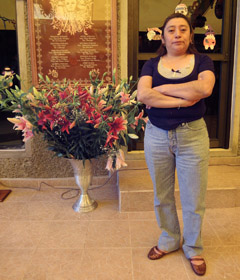 The lady of the house is Dona Antonia Guerra Ramirez. Wearing jeans and a black T-shirt, her dark hair dyed a luminous shade of orange-yellow, she looks younger than her 46 years. Dona Ramirez welcomes me graciously. As we begin to chat, she tells me she applied twenty eight years ago, when she was just a teenager, to have the honor of taking care of the Niño Pa. While she waited these nearly three decades, she saved her money and planned. Eventually, she felt it necessary to build an entirely new wing onto one side of her house, and to put a roof over her courtyard—thus making a dry, airy outdoor space for the many pilgrims who come every day to see the statue. She also modernized and expanded her kitchen, making it easier for her to serve food to whoever arrives at her door.
The lady of the house is Dona Antonia Guerra Ramirez. Wearing jeans and a black T-shirt, her dark hair dyed a luminous shade of orange-yellow, she looks younger than her 46 years. Dona Ramirez welcomes me graciously. As we begin to chat, she tells me she applied twenty eight years ago, when she was just a teenager, to have the honor of taking care of the Niño Pa. While she waited these nearly three decades, she saved her money and planned. Eventually, she felt it necessary to build an entirely new wing onto one side of her house, and to put a roof over her courtyard—thus making a dry, airy outdoor space for the many pilgrims who come every day to see the statue. She also modernized and expanded her kitchen, making it easier for her to serve food to whoever arrives at her door.
Would I like a cup of coffee, she asks? I decline, but her offer reminds me of my little gift, and I hand her the bag of churros. “Por el niño,” I say, quite unnecessarily.
What is the difference between magic and mysticism; between faith and superstition?
Dona Ramirez is on a committee that maintains up-to-date requirements for those who hope to have the baby live in their house one day. Of the many rules, the most important are that you have to be from Xochimilcho, you must be Catholic, and you need to prove your absolute devotion to the Niño Pa, as the statue is never to be left alone. Caring for the baby, as well as welcoming and feeding his many visitors, is her full-time job, Dona Ramirez tells me. She worked for the Federal Government, in an administrative post for Mexico City’s police force, but was given a year’s leave of absence, so she could devote herself completely to the Niño Pa. I am amazed by this, and try to imagine how the higher-ups at the N.Y.P.D. would react if a New York cop made such a request.
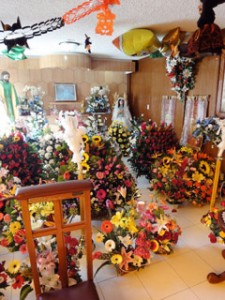 “It is very beautiful experience, but it is also a big responsibility,” Dona Ramirez says. I’d become increasingly curious why I was the only one visiting here today. My eyes wandered about the annex where we were standing, as I hoped to get my first glimpse of the Niño Pa. I’d seen pictures of him, and knew it was a smallish statue, so he might have been obscured by all the tributes and gifts brought by his fans. The courtyard was filled with masses of flower arrangements, and many dozens of mylar balloons decorated with images of Sponge Bob, Dia de Los Muertos skeletons, pop-eyed little angels, and of course, the Virgin of Guadalupe.
“It is very beautiful experience, but it is also a big responsibility,” Dona Ramirez says. I’d become increasingly curious why I was the only one visiting here today. My eyes wandered about the annex where we were standing, as I hoped to get my first glimpse of the Niño Pa. I’d seen pictures of him, and knew it was a smallish statue, so he might have been obscured by all the tributes and gifts brought by his fans. The courtyard was filled with masses of flower arrangements, and many dozens of mylar balloons decorated with images of Sponge Bob, Dia de Los Muertos skeletons, pop-eyed little angels, and of course, the Virgin of Guadalupe.
“Es possible lo veo?” I asked. May I see him?
Yes, Dona Ramirez replied, but I would have to wait until later. At this exact moment, the statue was in Jaltocan, another neighborhood of Xochimilcho, where a fiesta in his honor was being arranged. She expected him to return home by 8 p.m., at which time Dona Antonia would lead a rosary, and offer coffee and pastries to everyone who comes. Her manner was all quite matter of fact, as if she were detailing the schedule of her son, or younger brother: “he’s got school until 3 p.m., followed by band rehearsal, then soccer practice.”
What is the difference between magic and mysticism; between faith and superstition? There are those who truly believe in the power of certain rituals; others act by reflex, by making the sign of the cross, say, before stepping onto an airplane. Clearly, to wait nearly three decades, to scrimp and deny herself in order to prepare for this statue to reside at her house (and in the process, I subsequently learned, to forgo having a husband or a family of her own), Dona Ramirez must be of this first order of faith.
Rather than wait around, I decide to continue my search for the Niño Pa, and to see what today’s fiesta is like. About to bid farewell to this very kind woman, however, I still have one more question. It feels impolite, but I ask anyway. Dona Antonia Guerra Ramirez considers my inquiry with a small smile. No, she replies, in the time she’s had the Niño Pa in her house, she has not experienced anything miraculous herself. She’s seen no mud on his shoes, she volunteers. However, she has seen the statue work miracles for other people, and that has been enough for her, she says.
I find this strangely moving, and movingly strange.
The register book of families waiting to take annual care of the baby is full until 2042.
Outside, I climb back into the bicycle rickshaw. Before I can even say where I want to go to, the kid turns to me, yanks out one of his earbuds, and says, “Jaltocan?” Even he knows where the Niño Pa is today. Unbelievable!
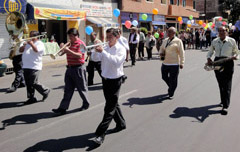 We travel down still more alleys, and cross over bridges that traverse narrow canals of slowly-drifting water. After another twenty minutes or so, off in the distance, I begin to hear the sound of cohetes—firecrackers! We emerge from a warren of shady residential streets onto a bright, busy thoroughfare. Here, I am astonished to see a huge crowd of people walking on the avenue, a helium-filled balloon tied to each of their wrists. It is a Wednesday, a few minutes before noon, and there must be least three hundred people on parade. Don’t they have to be at work? Or, like Dona Ramirez with the police department, does a request to spend the day with the Niño Pa immediately get you a day off?
We travel down still more alleys, and cross over bridges that traverse narrow canals of slowly-drifting water. After another twenty minutes or so, off in the distance, I begin to hear the sound of cohetes—firecrackers! We emerge from a warren of shady residential streets onto a bright, busy thoroughfare. Here, I am astonished to see a huge crowd of people walking on the avenue, a helium-filled balloon tied to each of their wrists. It is a Wednesday, a few minutes before noon, and there must be least three hundred people on parade. Don’t they have to be at work? Or, like Dona Ramirez with the police department, does a request to spend the day with the Niño Pa immediately get you a day off?
Wending its way alongside and through the crowd is una banda, a mariachi group comprised of three trumpets, two drums, one tuba, two trombonists, two clarinets and two saxophonists. They are playing traditional Mexican music: uptempo, brassy, and crazily alive. It is impossible to be in a bad mood when you are within earshot of mariachis. The sound grabs you by the heart, and hips, and shakes you free of life’s small worries.
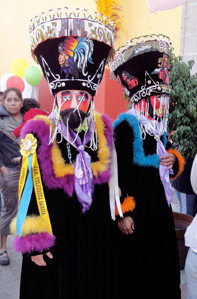 Adding to the festivity was a group of several dozen dancers, called chinelos, who are dressed in black velvet costumes, trimmed with feather boas, sequins and fur in vibrant shades of pink, yellow and turquoise. They wear carved wooden masks with Caucasian features: white skin, blue eyes, and beards that jut out to a sharp point from their chins. These startling get-ups are accessorized with large hats that resemble upside-down lamp shades, with dangling fringe all about their top. The chinelos whirl and dance about, like the Mummers of Philadelphia, or a New Orleans crewe during Mardi Gras. It is warm out, and ladies have set up folding tables on the sidewalk, where they are squeezing oranges and handing out free glasses of juice to all those in the parade.
Adding to the festivity was a group of several dozen dancers, called chinelos, who are dressed in black velvet costumes, trimmed with feather boas, sequins and fur in vibrant shades of pink, yellow and turquoise. They wear carved wooden masks with Caucasian features: white skin, blue eyes, and beards that jut out to a sharp point from their chins. These startling get-ups are accessorized with large hats that resemble upside-down lamp shades, with dangling fringe all about their top. The chinelos whirl and dance about, like the Mummers of Philadelphia, or a New Orleans crewe during Mardi Gras. It is warm out, and ladies have set up folding tables on the sidewalk, where they are squeezing oranges and handing out free glasses of juice to all those in the parade.
Not surprisingly, the Niño Pa leads the pack. I spy him off in the distance, being carried by the family who is hosting him that day, and shielded from the sun under an enormous blue beach umbrella. The statue moves ahead haltingly, as nearly every step of the way, someone steps forward, lifts the hem of his gown, and gives it a kiss. They then cross themselves while they bow and back away.
It seems as though the entire barrio has come to a standstill to accommodate this spectacle. All roads are blocked and long lines of cars wait patiently at intersections, with no honking, as the dancers, the mariachi band, and a steadily-growing crowd meanders slowly past. Bottle rockets continue to shoot off above our heads, streaking the blue sky with wispy trails of white smoke, before exploding in exceptionally loud booms. Mexicans love noise, and the noisier the better.
Someone hands me a balloon and a glass of orange juice; I join the procession, nearly giddy from the pageantry. As I stroll along, I learn a few things from an older gentleman walking beside me. Niño Pa combines the Spanish word for “boy” with one from Nahuatl (the ancient Aztec language) that means “place,” meaning the Niño Pa is a boy from this place, Xochilmilco. He explains that the register book of families waiting to take annual care of the baby is full until 2042. Around December 28 of every year, you can register to be granted the chance to host a daily parade like this, and there is always a long line of people hoping to secure a spot before that year’s calendar fills up. The gentleman asks me if I would like to get a better look at the baby. Grabbing my wrist, he leads me forward, through the marchers, until we are walking alongside the blue umbrella, and I can look underneath.
For today’s outing, the Niño Pa was dressed in an all-white gown; its profusion of satin and lace looked like a meringue.
 The Niño Pa has a diadem of three golden beams that jut out like antennae from his closely-cropped head of sculpted brunette hair. He has dark, squinting eyes, a high forehead, and pale pink skin. However, all flesh below his eyes, right down to the bottom of his chin, is painted a bright, blushing fuschia. His small lips, pursed into a teensy smile, are very red. For today’s outing, the Niño Pa was dressed in an all-white gown; its profusion of satin and lace looked like a meringue. He sat in a little wooden chair and was tied to it with a burgundy cord to keep him from slipping. The woman who carried the Niño Pa had a white towel tossed over one of her shoulders, as if he were a real baby who might at any moment burp or spit up.
The Niño Pa has a diadem of three golden beams that jut out like antennae from his closely-cropped head of sculpted brunette hair. He has dark, squinting eyes, a high forehead, and pale pink skin. However, all flesh below his eyes, right down to the bottom of his chin, is painted a bright, blushing fuschia. His small lips, pursed into a teensy smile, are very red. For today’s outing, the Niño Pa was dressed in an all-white gown; its profusion of satin and lace looked like a meringue. He sat in a little wooden chair and was tied to it with a burgundy cord to keep him from slipping. The woman who carried the Niño Pa had a white towel tossed over one of her shoulders, as if he were a real baby who might at any moment burp or spit up.
After walking for a half-hour or so, the parade arrived at Jaltocan’s Catholic church. The chinelos lined up in two rows, making a passageway into the front door, through which the family holding the Niño Pa proceeded, the old man and I following tight in their wake. Inside, the aisles and pews were packed with still more people—young, old, men, women, boys, girls, all holding balloons that bobbed about above their heads. I see women with their hair woven into braids that are so long, they snake all the way down their backs, reaching practically to their calves. The priest who leads the service is rail-thin, quite old, and somewhat unsteady on his feet. He is guided about by a lone acolyte, a chubby young girl who wears a track outfit in an eye-searing shade of aquamarine.
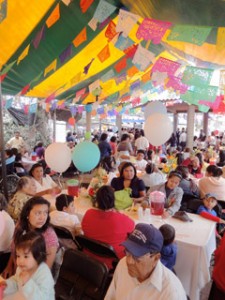 After the mass, there was a slow procession from the church to the house of Don Martin Salas and his wife. They were the couple who were carrying the Niño Pa in the parade, and would now be everyone’s host for lunch. The Salas family lives down near an embarcadero, where colorfully-painted barges take off to transport tourists up and down Xochimilco’s canals. A huge tent was set up, its fabric made of thick stripes of green and yellow. The green blocked the sun’s glare, but the yellow diffused it into golden stripes of light. There were banderas de papel, the Mexican cut-paper streamers, hanging everywhere. All of them have been stenciled with either an image of the infant Christ, or the words, “Bienvenidos Niño Pa” or “Gracias Niño Pa.” Still more helium balloons flutter about rectangular tables and chairs stretching out what seems the length of several football fields. Each table has a large flower arrangement, made from day lillies and zinnias. It looks like they are prepared to feed at least 500, maybe more.
After the mass, there was a slow procession from the church to the house of Don Martin Salas and his wife. They were the couple who were carrying the Niño Pa in the parade, and would now be everyone’s host for lunch. The Salas family lives down near an embarcadero, where colorfully-painted barges take off to transport tourists up and down Xochimilco’s canals. A huge tent was set up, its fabric made of thick stripes of green and yellow. The green blocked the sun’s glare, but the yellow diffused it into golden stripes of light. There were banderas de papel, the Mexican cut-paper streamers, hanging everywhere. All of them have been stenciled with either an image of the infant Christ, or the words, “Bienvenidos Niño Pa” or “Gracias Niño Pa.” Still more helium balloons flutter about rectangular tables and chairs stretching out what seems the length of several football fields. Each table has a large flower arrangement, made from day lillies and zinnias. It looks like they are prepared to feed at least 500, maybe more.
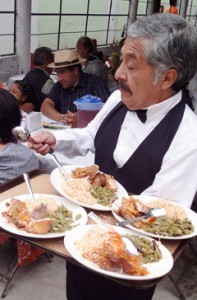 There is no “check-in” area, no seating plan, and most importantly, no ticket required to walk in and take a seat at any of these tables. I find an empty chair next to a group of women who are loudly talking to each other. They smile at me and wish me a “buenas tardes.” There are dozens of waiters in white shirts, black vests, and black bow ties, and they rush about with enormous platters of food, with the sauciest menu items served from terracotta bowls called cazuelas.
There is no “check-in” area, no seating plan, and most importantly, no ticket required to walk in and take a seat at any of these tables. I find an empty chair next to a group of women who are loudly talking to each other. They smile at me and wish me a “buenas tardes.” There are dozens of waiters in white shirts, black vests, and black bow ties, and they rush about with enormous platters of food, with the sauciest menu items served from terracotta bowls called cazuelas.
One of the women I’m seated with, I learn, is a sister to a good friend of Dona Salas, our hostess. Some might think this a tenuous connection, but this woman feels enough kinship that, when the waiters lag slightly behind in their luncheon service, she gets up from the table and goes off herself to help move things along. I soon see her ferrying about baskets of fresh tortillas.
“This kind of community, this feeling of solidarity, is deep inside the mentality of the Mexican people,” one woman says to me. “It is not lost, but it is hidden under the earth.”
The food is all delicious, and I eat two plates, then three, goaded on by the appreciative nods of my table mates who seem not only to approve of, but to be personally gratified by, my gluttony.
I want to talk about this more, but the smells coming up from the platters and cazuelas is so tempting, I load up my plate, and begin to eat instead.
 There is rice, turned a dull red by being cooked with carrots and tomato juice. Nopales (paddle cactus), that were boiled and then fried with chiles and onions. Black beans in a thick garlic-laced broth. A green salad with radishes and avocado. And, finally, carnitas, or savory hunks of pork that have been slow-cooked in garlic, orange juice and achiote, and then grilled over a wooden fire. There are no knives or forks. We eat with a soup spoon, and our fingers. The food is all delicious, and I eat two plates, then three, goaded on by the appreciative nods of my table mates who seem not only to approve of, but to be personally gratified by, my gluttony. I wash it all down with many glasses of aqua fresca, a purple-red punch made from jamaica blossoms steeped with water and honey.
There is rice, turned a dull red by being cooked with carrots and tomato juice. Nopales (paddle cactus), that were boiled and then fried with chiles and onions. Black beans in a thick garlic-laced broth. A green salad with radishes and avocado. And, finally, carnitas, or savory hunks of pork that have been slow-cooked in garlic, orange juice and achiote, and then grilled over a wooden fire. There are no knives or forks. We eat with a soup spoon, and our fingers. The food is all delicious, and I eat two plates, then three, goaded on by the appreciative nods of my table mates who seem not only to approve of, but to be personally gratified by, my gluttony. I wash it all down with many glasses of aqua fresca, a purple-red punch made from jamaica blossoms steeped with water and honey.
Once I am completely sated, nearly full to bursting, I turn to my table mates and ask about the logistics of such a meal. How did one family make all this food? How long had they been cooking? How many people, other than all these waiters, were required to help them? I have seen my host and hostess several times throughout lunch, passing by, greeting friends, never pausing or sitting themselves, so focussed are they on the comfort of their guests.
“I’m exhausted just looking at them,” I say. “How do they do it?”
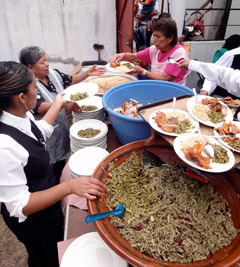 The women look at me, rather confused. I sense that they’ve been to enough parties thrown in this baby’s honor—and, doubtless, they’ve cooked meals of their own, just like this one—that a fiesta like today’s no longer strikes them as remarkable. (It’s as if I’m standing at the beach, marveling at the fact of waves rolling in.) For these women of Xochimilco, hosting a lunch for 500 strangers is altogether natural.
The women look at me, rather confused. I sense that they’ve been to enough parties thrown in this baby’s honor—and, doubtless, they’ve cooked meals of their own, just like this one—that a fiesta like today’s no longer strikes them as remarkable. (It’s as if I’m standing at the beach, marveling at the fact of waves rolling in.) For these women of Xochimilco, hosting a lunch for 500 strangers is altogether natural.
One of them finally speaks. “You’ve seen the Niño Pa?” she asks.
“Si, senora,” I reply.
“Well, imagine that this little doll is not just a doll but God. When you are around it, you are in the presence of God. Whatever you could do, you would do. Whatever you would do, will still not be enough if you truly believe you are in the presence of God, right?”
I don’t know how to respond to this, other than by nodding my head silently.
The ladies go back to talking amongst themselves. After awhile, I get up, slip away from the table, and begin to slowly walk along the canals of Xochimilco in the warmth of a late afternoon’s sunshine. I have the glorious, guilt-free feeling of being overfed I usually only experience on Thanksgiving day. How weird and wonderful this day has been! A total stranger, I was welcomed into people’s homes, and invited to be their guest at a truly incredible feast. I feel dazzled and dazed, as if I’m floating on a cloud of love.



